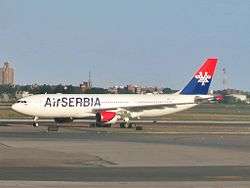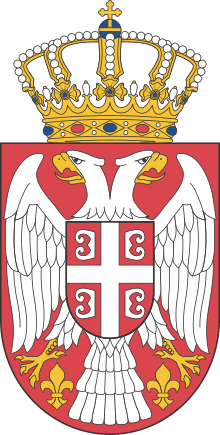Economy of Serbia
The economy of Serbia is a service-based upper middle income economy with the tertiary sector accounting for two-thirds of total gross domestic product (GDP) and functions on the principles of the free market. Nominal GDP in 2019 is projected to reach $51.523 billion, which is $7,398 per capita, while GDP based on purchasing power parity (PPP) stood at $129.298 billion, which is $18,564 per capita.[4]
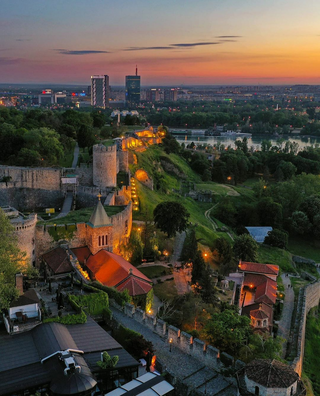 Belgrade, the financial center of Serbia | |
| Currency | Serbian dinar (RSD, дин) |
|---|---|
| Calendar year | |
Trade organisations | CEFTA, BSEC, Mini Schengen Zone |
Country group |
|
| Statistics | |
| Population | |
| GDP | |
| GDP rank | |
GDP growth | |
GDP per capita | |
GDP per capita rank | |
GDP by sector |
|
| 1.4% (2020 est.)[5] | |
Population below poverty line | |
Labour force | |
Labour force by occupation |
|
| Unemployment | |
Average gross salary | RSD 82,836 | €705 | $777 monthly (January 2020)[19] |
Average net salary | RSD 59,941 | €510 | $562 monthly (January 2020)[20] |
Main industries | motor vehicle, base metals, food processing, machinery, chemicals, tires, pharmaceuticals |
| External | |
| Exports | |
Export goods | motor vehicles ($2.42bn), electrical machines ($2.033bn), non-ferrous metals ($2.005bn), rubber nad plastics products ($1.670bn), chemicals and chemical products ($1.193bn) |
Main export partners |
|
| Imports | |
Import goods | chemicals and chemical products ($2.408bn), general purpose machinery ($2.100bn), petroleum and natural gas ($1.977bn), motor vehicles ($1.818bn), basic metals ($1.740bn), |
Main import partners | |
FDI stock |
|
Gross external debt | |
| Public finances | |
| +0.2% (of GDP) (2017 est.)[24] | |
| Revenues | 17.69 billion (2017 est.)[24][note 1] |
| Expenses | 17.59 billion (2017 est.)[24] |
| Economic aid | €2.6 billion of EU IPA (2001–2014)[26] €1.5 billion of EU IPA (2014–2020)[27] |
Foreign reserves | |
| Economy of Serbia |
|---|
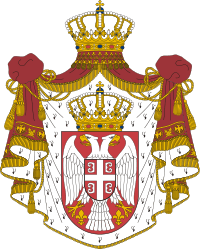 |
| Overview |
| Sectors |
| Serbia topics |
|
The strongest sectors of Serbia's economy are energy, automotive industry, machinery, mining, and agriculture.[32] Primary industrial exports are automobiles, base metals, furniture, food processing, machinery, chemicals, sugar, tires, clothes, pharmaceuticals.[24] Trade plays a major role in Serbian economic output. The main trading partners are Germany, Italy, Russia, China, and neighboring Balkan countries.[24]
Belgrade is the capital and economic heart of Serbia and home to most major Serbian and international companies operating in the country, as well as the National Bank of Serbia and the Belgrade Stock Exchange. Novi Sad is the second largest city and the most important economic hub after Belgrade.
Historical preview
In the late 1980s, at the beginning of the process of economic transition from a planned economy to a market economy, Serbia's economy had a favorable position in comparison to most of the Eastern Bloc countries, but it was gravely impacted by the Yugoslav Wars and UN sanctions and trade embargo during the 1990s.[33] At the same time, the country experienced a serious "brain drain".[34] After the overthrow of Slobodan Milošević in 2000, Serbia went through a process of transition to a market-based economy and experienced fast economic growth. During that period, the Serbian economy grew 4-5% annually, average wages quadrupled, and economic and social opportunities dramatically improved. During the Great Recession, Serbia marked a decline in its economy of 3.1% in 2009, and following years of economic stagnation pre-crisis level of GDP was reached only in 2016.
Since 2014, the country has been in the process of accession negotiations to join the European Union.[35]
Macroeconomic trends
Economic growth
The average growth of Serbia's GDP in the last five years was 4% per year. GDP structure by sector is: services 67.9%, industry 26.1%, agriculture 6.0%.[8]
| GDP Growth | ||||||||||||||||||||
|---|---|---|---|---|---|---|---|---|---|---|---|---|---|---|---|---|---|---|---|---|
| Year | 2000 | 2001 | 2002 | 2003 | 2004 | 2005 | 2006 | 2007 | 2008 | 2009 | 2010 | 2011 | 2012 | 2013 | 2014 | 2015 | 2016 | 2017 | 2018 | 2019 |
| Rate | 7.8% | 5.0% | 7.1% | 4.4% | 9.0% | 5.5% | 9.7% | 6.4% | 5.7% | -2.7% | 0.7% | 2.0% | -0.7% | 2.9% | -1.6% | 1.8% | 3.3% | 2.0% | 4.4% | 4.2% |
| Source: World Bank[8] | ||||||||||||||||||||
Public finances
Serbia's public debt relative to GDP from 2000 to 2008 decreased by 140.1 percentage points, and then started increasing again as the government was fighting effects of worldwide 2008 financial crisis. In 2018, the public debt stood at 53.8% of GDP.[36]
| Public debt | |||||||||||||||
|---|---|---|---|---|---|---|---|---|---|---|---|---|---|---|---|
| Year | 2000 | 2002 | 2004 | 2006 | 2008 | 2009 | 2010 | 2011 | 2012 | 2013 | 2014 | 2015 | 2016 | 2017 | 2018 |
| Billions EUR | 14.17 | 13.43 | 11.02 | 9.35 | 8.78 | 9.85 | 12.16 | 14.78 | 17.72 | 20.14 | 22.76 | 24.81 | 24.71 | 23.21 | 23.01 |
| Share of GDP | 201.2% | 68.3% | 52.6% | 35.9% | 28.3% | 32.8% | 41.8% | 45.4% | 56.2% | 59.6% | 70.4% | 74.7% | 71.9% | 61.5% | 53.8% |
| Source: Ministry of Finance of Serbia Public debt Administration | |||||||||||||||
Serbian foreign exchange reserves were highly augmented from 2000 to 2009, when they amounted 10.6 billion euros and have stayed at that level ever since.
| Foreign exchange reserves | |||||||||||||||
|---|---|---|---|---|---|---|---|---|---|---|---|---|---|---|---|
| Year | 2000 | 2002 | 2004 | 2006 | 2008 | 2009 | 2010 | 2011 | 2012 | 2013 | 2014 | 2015 | 2016 | 2017 | 2018 |
| Central bank (bln. EUR) | 0.55 | 2.19 | 3.10 | 9.02 | 8.16 | 10.60 | 10.00 | 12.06 | 10.91 | 11.19 | 9.91 | 10.38 | 10.20 | 9.96 | 11.26 |
| Comm. banks (bln. EUR) | 0.39 | 0.68 | 0.59 | 0.52 | 0.92 | 1.42 | 1.68 | 0.80 | 1.06 | 0.91 | 1.73 | 1.43 | 1.56 | 1.11 | 1.63 |
| Total (bln. EUR) | 0.95 | 2.86 | 3.70 | 9.54 | 9.08 | 12.03 | 11.69 | 12.87 | 11.97 | 12.10 | 11.64 | 11.81 | 11.76 | 11.07 | 12.89 |
| Source: National Bank of Serbia | |||||||||||||||
Currency and inflation
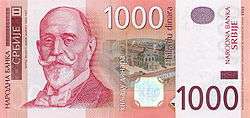
The official currency in Serbia is the Serbian dinar and its earliest use dates back to 1214.
Serbia historically has battled high inflation, especially during the 1980s and 1990s. In 1992 and 1993, it experienced a period of hyperinflation which lasted for a total of 25 months.[37] In 1993, the monthly inflation rate stood at a staggering 313 million percent.[37] Since the early 2000s, inflation rate has stabilized and in the last couple of years a relatively low level of inflation was recorded.
| Inflation and Serbian dinar Exchange Rates | |||||||||||||||
|---|---|---|---|---|---|---|---|---|---|---|---|---|---|---|---|
| Year | 2002 | 2004 | 2006 | 2008 | 2009 | 2010 | 2011 | 2012 | 2013 | 2014 | 2015 | 2016 | 2017 | 2018 | 2019 |
| Inflation rate | 19.5% | 11.0% | 11.7% | 12.4% | 8.1% | 6.1% | 11.1% | 7.3% | 7.7% | 2.1% | 1.4% | 1.1% | 3% | 2% | 1.9% |
| USD/RSD | 58.98 | 57.94 | 59.98 | 62.90 | 66.73 | 79.28 | 80.87 | 86.18 | 83.13 | 99.46 | 111.25 | 117.13 | 99.11 | 103.39 | 104.92 |
| EUR/RSD | 61.51 | 78.89 | 79.00 | 88.60 | 95.89 | 105.50 | 104.64 | 113.72 | 114.64 | 120.96 | 121.63 | 123.47 | 118.45 | 118.19 | 117.59 |
| Source: World Bank,National Bank of Serbia; Note: All exchange data retrieved each year on December 31 | |||||||||||||||
External trade
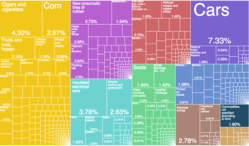
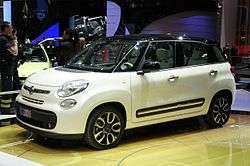
Serbia has a wide-range of free trade agreements with foreign countries and trading blocs.
Serbia signed a free trade agreement with the European Union in 2008 enabling exports of all products originating from Serbia without customs and other fees.[38] For a limited number of products (baby beef, sugar, and wine), annual import quotas remain in effect. As of 2016, the EU countries were the largest trading partners of Serbia with 64.4% of country's total foreign trade.[39]
Serbia signed the CEFTA enabling exports of all products originating from Serbia without customs and other fees to the neighbouring countries: Albania, Bosnia and Herzegovina, North Macedonia, Moldova, Montenegro and Kosovo.[38] In 2016, the CEFTA countries were the second largest trading partners of Serbia.[40]
Serbia signed a free-trade agreement with EFTA members (Switzerland, Norway, Iceland) in 2009.[41]
The Serbian free-trade agreement with Russia was implemented since 2000; for a limited number of products, annual import quotas remain in effect.[38][42] Free-trade agreement with Turkey has been implemented since 2010.[42] Trade with the United States is pursued under the Generalized System of Preferences (GSP) with a preferential duty-free entry for approximately 4,650 products.[43]
| External trade | ||||||||||||||||
|---|---|---|---|---|---|---|---|---|---|---|---|---|---|---|---|---|
| Year | 2000 | 2002 | 2004 | 2006 | 2008 | 2010 | 2011 | 2012 | 2013 | 2014 | 2015 | 2016 | 2017 | 2018 | 2019 | |
| Exports (mil. USD): | 1,558 | 2,074 | 3,523 | 6,431 | 10,974 | 9,794 | 11,780 | 11,353 | 14,614 | 14,843 | 13,379 | 14,883 | 16,992 | 19,227 | 19,630 | |
| Imports (mil. USD): | 5,614 | 5,614 | 10,755 | 13,174 | 24,332 | 16,471 | 19,862 | 19,014 | 20,543 | 20,650 | 18,218 | 19,247 | 21,946 | 25,883 | 26,730 | |
| Balance (mil. USD): | -1,772 | -3,540 | -7,232 | -6,743 | -13,358 | -6,677 | -8,082 | -7,661 | -5,929 | -5,806 | -4,839 | -4,363 | -4,954 | -6,657 | -7,101 | |
| Exports/Imports (%): | 46.8 | 36.9 | 32.8 | 48.8 | 45.1 | 59.5 | 59.3 | 59.7 | 71.1 | 71.9 | 73.4 | 78.8 | 77.4 | 74.3 | 73.4 | |
| Source: Statistical Office of Serbia | ||||||||||||||||
Foreign direct investments
Attracting foreign direct investments is set as a priority for the government of Serbia, which provides both financial and tax incentives to companies willing to invest.[44] Leading investor nations in Serbia include: Germany, Italy, United States, China, Austria, Norway, and Greece.[45] Majority of FDI went into automotive industry, food and beverage industry, machinery, textile and clothing.[45]
Blue-chip corporations making investments in manufacturing sector include: Fiat Chrysler Automobiles, Bosch, Michelin, Siemens, Panasonic, Continental, Schneider Electric, Philip Morris, LafargeHolcim, PepsiCo, Coca-Cola, Carlsberg and others.[46] In the energy sector, Russian energy giants, Lukoil and Gazprom have made large investments.[47] In metallurgy sector, Chinese steel and copper giants, Hesteel and Zijin Mining have acquired steel mill in Smederevo andcopper mining complex in Bor, respectively.[48] The financial sector has attracted investments from Italian banks such as Intesa Sanpaolo and UniCredit, Crédit Agricole and Société Générale from France, Erste Bank and Raiffeisen from Austria, among others.[49] ICT and telecommunications saw investments from likes such as Microsoft, Telenor, Telekom Austria, and NCR. In retail sector, biggest foreign investors are Dutch Ahold Delhaize, German Metro AG and Schwarz Gruppe, Greek Veropoulos, and Croatian Fortenova.
| Foreign direct investments | ||||||||||||||||||
|---|---|---|---|---|---|---|---|---|---|---|---|---|---|---|---|---|---|---|
| Year | 2000 | 2002 | 2003 | 2004 | 2005 | 2006 | 2007 | 2008 | 2009 | 2010 | 2011 | 2012 | 2013 | 2014 | 2015 | 2016 | 2017 | 2018 |
| Total (mil. USD) | 54 | 546 | 1,511 | 1,077 | 1,579 | 5,663 | 4,389 | 3,407 | 2,729 | 1,549 | 3,018 | 2,629 | 1,518 | 1,550 | 2,114 | 2,080 | 2,867 | 3,984 |
| Per capita (USD) | 7.2 | 72.8 | 202.0 | 144.3 | 212.2 | 764.0 | 594.6 | 461.5 | 372.8 | 212.5 | 415.8 | 365.2 | 211.9 | 216.7 | 297.7 | 292.9 | 320.6 | 569.1 |
| Source: Development Agency of Serbia National Bank of Serbia | ||||||||||||||||||
Economic sectors
Agriculture
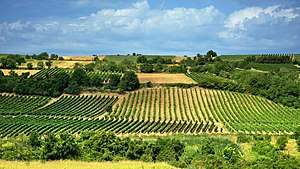
Serbia has very favourable natural conditions (land and climate) for varied agricultural production. It has 5,056,000 ha of agricultural land (0.7 ha per capita), out of which 3,294,000 ha is arable land (0.45 ha per capita).[50] In 2016, Serbia exported agricultural and food products worth $3.2 billion, and the export-import ratio was 178%.[51] Agricultural exports constitute more than one-fifth of all Serbia's sales on the world market. Serbia is one of the largest provider of frozen fruit to the EU (largest to the French market, and 2nd largest to the German market).[52] Agricultural production is most prominent in Vojvodina on the fertile Pannonian Plain. Other agricultural regions include Mačva, Pomoravlje, Tamnava, Rasina, and Jablanica.[53] In the structure of the agricultural production 70% is from the crop field production, and 30% is from the livestock production.[53] Serbia is world's second largest producer of plums (582,485 tons; second to China), second largest of raspberries (89,602 tons, second to Poland), it is also significant producer of maize (6.48 million tons, ranked 32nd in the world) and wheat (2.07 million tons, ranked 35th in the world).[54][55] Other important agricultural products are: sunflower, sugar beet, soybean, potato, apple, pork meat, beef, poultry and dairy.
There are 56,000 ha of vineyards in Serbia, producing about 230 million litres of wine annually.[54][50] Most famous viticulture regions are located in Vojvodina and Šumadija.
Energy
The energy sector is one of the largest and most important sectors to the country's economy. Serbia is a net exporter of electricity and importer of key fuels (such as oil and gas).
Serbia has an abundance of coal, and significant reserves of oil and gas. Serbia's proven reserves of 5.5 billion tons of coal lignite are the 5th largest in the world (second in Europe, after Germany).[56][57] Coal is found in two large deposits: Kolubara (4 billion tons of reserves) and Kostolac (1.5 billion tons).[56] Despite being small on a world scale, Serbia's oil and gas resources (77.4 million tons of oil equivalent and 48.1 billion cubic meters, respectively) have a certain regional importance since they are largest in the region of former Yugoslavia as well as the Balkans (excluding Romania).[58] Almost 90% of the discovered oil and gas are to be found in Banat and those oil and gas fields are by size among the largest in the Pannonian basin but are average on a European scale.[59]
The production of electricity in 2018 in Serbia was 38.3 billion kilowatt-hours (KWh), while the final electricity consumption amounted to 28.1 billion kilowatt-hours (KWh).[60] Most of the electricity produced comes from thermal-power plants (71% of all electricity) and to a lesser degree from hydroelectric-power plants (24%) and wind energy (3%).[61] There are 6 lignite-operated thermal-power plants with an installed power of 3,936 MW; largest of which are 1,502 MW-Nikola Tesla 1 and 1,160 MW-Nikola Tesla 2, both in Obrenovac.[62] Total installed power of 9 hydroelectric-power plants is 2,831 MW, largest of which is Đerdap 1 with capacity of 1,026 MW.[63] In addition to this, there are mazute and gas-operated thermal-power plants with an installed power of 353 MW.[64] The entire production of electricity is concentrated in Elektroprivreda Srbije (EPS), public electric-utility power company.
The current oil production in Serbia amounts to over 1.1 million tons of oil equivalent[65] and satisfies some 43% of country's needs while the rest is imported.[66] National petrol company, Naftna Industrija Srbije (NIS), was acquired in 2008 by Gazprom Neft. The company's refinery in Pančevo (capacity of 4.8 million tons) is one of the most modern oil-refineries in Europe; it also operates network of 334 filling stations in Serbia (74% of domestic market) and additional 36 stations in Bosnia and Herzegovina, 31 in Bulgaria, and 28 in Romania.[67][68] There are 155 kilometers of crude oil pipelines connecting Pančevo and Novi Sad refineries as a part of trans-national Adria oil pipeline.[69]
Serbia is heavily dependent on foreign sources of natural gas, with only 17% coming from domestic production (totalling 491 million cubic meters in 2012) and the rest is imported, mainly from Russia (via gas pipelines that run through Ukraine and Hungary).[66] Srbijagas, public company, operates the natural gas transportation system which comprise 3,177 kilometers of trunk and regional natural gas pipelines and a 450 million cubic meter underground gas storage facility at Banatski Dvor.[70]
Industry
The industry is the economy sector which was hardest hit by the UN sanctions and trade embargo and NATO bombing during the 1990s and transition to market economy during the 2000s.[71] The industrial output saw dramatic downsizing: in 2013 it was expected to be only a half of that of 1989.[72] Main industrial sectors include: automotive, mining, non-ferrous metals, food-processing, electronics, pharmaceuticals, clothes. Serbia has 14 free economic zones as of September 2017,[73] in which many foreign direct investments are realized.
Automotive industry (with Fiat Chrysler Automobiles as a forebearer) is dominated by cluster located in Kragujevac and its vicinity, and contributes to export with about $2 billion.[74] Country is a leading steel producer in the wider region of Southeast Europe and had production of nearly 2 million tons of raw steel in 2018, coming entirely from Smederevo steel mill, owned by the Chinese Hesteel.[75] Serbia's mining industry is comparatively strong: Serbia is the 18th largest producer of coal (7th in the Europe) extracted from large deposits in Kolubara and Kostolac basins; it is also world's 23rd largest (3rd in Europe) producer of copper which is extracted by Zijin Bor Copper, a large copper mining company, acquired by Chinese Zijin Mining in 2018; significant gold extraction is developed around Majdanpek. Serbia notably manufactures intel smartphones named Tesla smartphones.[76]
Food industry is well known both regionally and internationally and is one of the strong points of the economy.[77] Some of the international brand-names established production in Serbia: PepsiCo and Nestlé in food-processing sector; Coca-Cola (Belgrade), Heineken (Novi Sad) and Carlsberg (Bačka Palanka) in beverage industry; Nordzucker in sugar industry.[52] Serbia's electronics industry had its peak in the 1980s and the industry today is only a third of what it was back then, but has witnessed a something of revival in last decade with investments of companies such as Siemens (wind turbines) in Subotica, Panasonic (lighting devices) in Svilajnac, and Gorenje (electrical home appliances) in Valjevo.[78] The pharmaceutical industry in Serbia comprises a dozen manufacturers of generic drugs, of which Hemofarm in Vršac and Galenika in Belgrade, account for 80% of production volume. Domestic production meets over 60% of the local demand.[79]
Telecommunications and IT industry
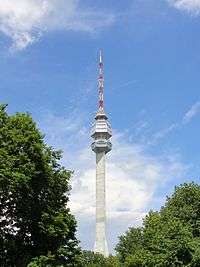
Fixed telephone lines connect 89% of households in Serbia, and with about 8.82 million users the number of cellphones surpasses the total population of Serbia by 25%. The largest mobile operator is Telekom Srbija with 4.06 million subscribers, followed by Telenor with 2.73 million users and Vip mobile with about 2.03 million.[80] Some 58% of households have fixed-line (non-mobile) broadband Internet connection while 67% are provided with pay television services (i.e. 38% cable television, 17% IPTV, and 10% satellite).[81] Digital television transition has been completed in 2015 with DVB-T2 standard for signal transmission.[82]
The Serbian IT industry is rapidly growing and changing pace. In 2018, IT services exports reached $1.3 billion.[83] With 6,924 companies in the IT sector (2013 data), Belgrade is one of the information technology centers in this part of Europe, with strong growth.[84] Microsoft Development Center located in Belgrade was at the time of its establishment fifth such center in the world.[85] Many world IT companies choose Belgrade as regional or European center such as Asus,[86] Intel,[87] Dell,[88] Huawei, NCR,[89] Ubisoft[90] etc. These companies have taken advantage of Serbia's large pool of engineers and relatively low wages.
Large investments by global tech companies like Microsoft, typical of the 2000s, are being eclipsed by a growing number of domestic startups which obtain funding from domestic and international investors. What brought companies like Microsoft in the first place was a large pool of talented engineers and mathematicians.[91] In just the first quarter of 2016, more than US$65 million has been raised by Serbian startups including $45 million for Seven Bridges (a Bioinformatics firm) and $14 million for Vast (a data analysis firm).[92][93] One of the most successful startups have been Nordeus which was founded in Belgrade in 2010 and is one of Europe's fastest-growing companies in the field of computer games (the developer of Top Eleven Football Manager, a game played by over 20 million people).[94]

.jpg)
Tourism
The touristic sector accounted for 1.4% of GDP in 2017 and employs some 75,000 people, about 3% of the country's workforce.[8][95] Foreign exchange earnings from tourism in 2018 were estimated at $1.5 billion.[96]
Serbia is not a mass-tourism destination but nevertheless has a diverse range of touristic products.[97] In 2018, total of over 3.4 million tourists were recorded in accommodations, of which half were foreign.[98]
Tourism is mainly focused on the mountains and spas of the country, which are mostly visited by domestic tourists, as well as Belgrade which is preferred choice of foreign tourists. The most famous mountain resorts are Kopaonik, Stara Planina, and Zlatibor. There are also many spas in Serbia, the biggest of which is Vrnjačka Banja, Soko Banja, and Banja Koviljača. City-break and conference tourism is developed in Belgrade (which was visited by 938,448 foreign tourists in 2018, more than a half of all international visits to the country) and to a lesser degree Novi Sad. Other touristic products that Serbia offer are natural wonders like Đavolja varoš, Christian pilgrimage to the many Orthodox monasteries across the country and the river cruising along the Danube. There are several internationally popular music festivals held in Serbia, such as EXIT (with 25–30,000 foreign visitors coming from 60 different countries) and the Guča trumpet festival.[99]
Transport
Serbia has a strategic transportation location since the country's backbone, Morava Valley, represents by far the easiest route of land travel from continental Europe to Asia Minor and the Near East.
Serbian road network carries the bulk of traffic in the country. Total length of roads is 45,419 km of which 915 km are "class-Ia state roads" (i.e. motorways); 4,481 km are "class-Ib state roads" (national roads); 10,941 km are "class-II state roads" (regional roads) and 23,780 km are "municipal roads".[100][101][102] The road network, except for the most of class-Ia roads, are of comparatively lower quality to the Western European standards because of lack of financial resources for their maintenance in the last 20 years.
Over 300 kilometers of new motorways has been constructed in the last decade and additional 142 kilometers are currently under construction: A5 motorway (from north of Kruševac to Čačak) and 30 km-long segment of A2 (between Čačak and Požega).[103][104] Coach transport is very extensive: almost every place in the country is connected by bus, from largest cities to the villages; in addition there are international routes (mainly to countries of Western Europe with large Serb diaspora). Routes, both domestic and international, are served by more than 100 bus companies, biggest of which are Lasta and Niš-Ekspres. As of 2018, there were 1,959,584 registered passenger cars or 1 passenger car per 3.5 inhabitants.[105]
Serbia has 3,819 kilometers of rail tracks, of which 1,279 are electrified and 283 kilometers are double-track railroad.[54] The major rail hub is Belgrade (and to a lesser degree Niš), while the most important railroads include: Belgrade–Bar (Montenegro), Belgrade–Šid–Zagreb (Croatia)/Belgrade–Niš–Sofia (Bulgaria) (part of Pan-European Corridor X), Belgrade–Subotica–Budapest (Hungary) and Niš–Thessaloniki (Greece). Although still a major mode of freight transportation, railroads face increasing problems with the maintenance of the infrastructure and lowering speeds. The rail services are operated by Srbija Voz (passenger transport) and Srbija Kargo (freight transport).[106]
There are three airports with regular passenger traffic. Belgrade Nikola Tesla Airport served 5.6 million passengers in 2018 and is a hub of flagship carrier Air Serbia which carried some 2.5 million passengers in 2018.[107] Niš Constantine the Great Airport is mainly catering low-cost airlines.[108] Morava Airport is currently only served by Air Serbia.
Serbia has a developed inland water transport since there are 1,716 kilometers of navigable inland waterways (1,043 km of navigable rivers and 673 km of navigable canals), which are almost all located in northern third of the country.[54] The most important inland waterway is the Danube (part of Pan-European Corridor VII). Other navigable rivers include Sava, Tisza, Begej and Timiş River, all of which connect Serbia with Northern and Western Europe through the Rhine–Main–Danube Canal and North Sea route, to Eastern Europe via the Tisza, Begej and Danube Black Sea routes, and to Southern Europe via the Sava river. More than 2 million tons of cargo were transported on Serbian rivers and canals in 2016 while the largest river ports are: Novi Sad, Belgrade, Pančevo, Smederevo, Prahovo and Šabac.[54][109]
Labour
In 2018, the labour force was estimated at 3.24 million and employment stood at 2.83 million persons (formal employment amounted to 2.28 million while informal was at 0.55 million).[110] Employment rate (among population aged 15 and over) is comparatively low and stood at 47.6%; of those employed 15.9% worked in agriculture, 28.1% in industry, and 56% in services.[110] The unemployment rate has been in double digits throughout the post-communist era, reaching peak at about 25% during the early and late 2000s. Since then, the rate has decreased substantially, with the creation of new jobs in primarily private sector, reaching 9.5% in 2020.[110]
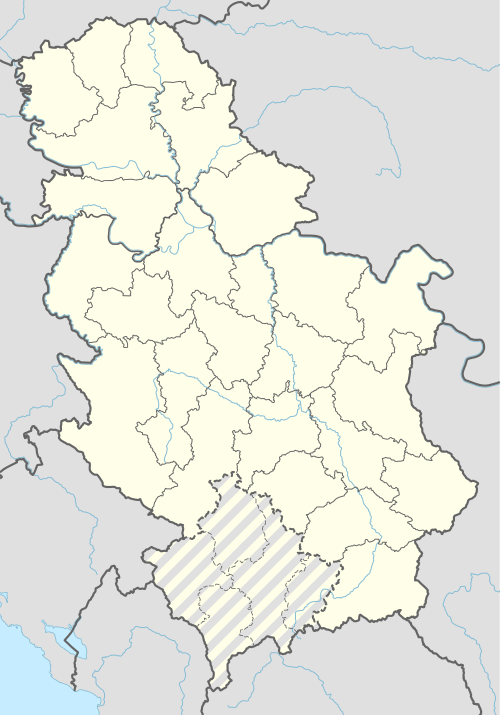
Note: districts in purple on the map had unemployment rate in 2019 - below 10%, blue in the range of 10% – 15%, orange in the range of 15% – 20%; and red – 20% and over.[111]
According to the latest annual report of the Statistical Office of the Republic of Serbia, the net average monthly salary in April 2020 amounted to 58,932 Serbian dinars or 502 euros. In 2019 the net median salary amounted to 44 530 RSD or 379 euros, meaning that 50% of employees earned wages and salaries up to the mentioned amount.[112]

Note: districts in purple on the map had net average monthly salary in April 2020 – €500 and over, blue in the range of €450 – €500; orange in the range of €400 – €450, and red – below €400.[113]
Regional economies
The list includes statistical regions of Serbia by GDP, share of total GDP and GDP per capita in 2017:[114]
| Rank | Region | Total GDP (Bln. $) | Share of total GDP | GDP per capita ($) |
|---|---|---|---|---|
| 1 | Belgrade Region | 19.46 | 40.4% | 11,752 |
| 2 | Vojvodina | 12.77 | 26.5% | 6,612 |
| 3 | Šumadija and Western Serbia | 9.25 | 19.2% | 4,554 |
| 4 | Southern and Eastern Serbia | 6.64 | 13.8% | 4,249 |
Companies
The list includes ten largest Serbian companies by revenue in 2018 (revenue and employees figures without subsidiaries):[115]
| Rank | Company | Headquarters | Industry | Revenue (Mil. €) | Employees | |
|---|---|---|---|---|---|---|
| 1 | Elektroprivreda Srbije | Belgrade | Energy | 2,214 | 25,761 | |
| 2 | Naftna Industrija Srbije | Novi Sad | Petroleum | 2,168 | 4,099 | |
| 3 | Hesteel Serbia | Belgrade | Metallurgy | 882 | 4,908 | |
| 4 | Ahold Delhaize Serbia | Belgrade | Retail | 843 | 12,629 | |
| 5 | FCA Srbija | Kragujevac | Automotive | 740 | 2,280 | |
| 6 | Telekom Srbija | Belgrade | Telecommunications | 718 | 7,777 | |
| 7 | Mercator-S | Novi Sad | Retail | 705 | 8,124 | |
| 8 | EPS Distribucija | Belgrade | Electric utility | 682 | 3,426 | |
| 9 | Tigar Tyres | Pirot | Manufacturing | 681 | 3,388 | |
| 10 | Srbijagas | Novi Sad | Energy | 665 | 1,071 | |
The list includes ten largest Serbian companies by net income in 2018 (net income and employees figures without subsidiaries):[115]
| Rank | Company | Headquarters | Industry | Net income (Mil. €) | Employees | |
|---|---|---|---|---|---|---|
| 1 | Serbia Zijin Bor Copper | Bor | Mining | 762 | 4,951 | |
| 2 | Belgrade Nikola Tesla Airport | Belgrade | Transport | 450 | 1,556 | |
| 3 | Naftna Industrija Srbije | Novi Sad | Petroleum | 213 | 4,099 | |
| 4 | Al Dahra Serbia | Belgrade | Agriculture | 103 | 188 | |
| 5 | Telekom Srbija | Belgrade | Telecommunications | 92 | 7,777 | |
| 6 | Telenor Serbia | Belgrade | Telecommunications | 76 | 705 | |
| 7 | Srbijagas | Novi Sad | Energy | 64 | 1,071 | |
| 8 | SFS AD Paraćin | Paraćin | Manufacturing | 45 | 527 | |
| 9 | Tigar Tyres | Pirot | Manufacturing | 41 | 3,388 | |
| 10 | Posh properties | Belgrade | Real estate | 40 | 0 | |
See also
References
- "World Economic Outlook Database, January 2020". IMF.org. International Monetary Fund. Retrieved 8 January 2020.
- "World Bank Country and Lending Groups". datahelpdesk.worldbank.org. World Bank. Retrieved 29 September 2019.
- "Population on 1 January". www.stat.gov.rs/en-us/. Statistical Office of the Republic of Serbia. Retrieved 1 July 2020.
- "World Economic Outlook Database, October 2019". IMF.org. International Monetary Fund. Retrieved 1 February 2020.
- "World Economic Outlook Database, April 2020". imf.org. International Monetary Fund. Retrieved 16 April 2020.
- www.stat.gov.rs. Statistical Office of the Republic of Serbia https://www.stat.gov.rs/en-US. Retrieved 2 June 2020. Missing or empty
|title=(help) - "Global Economic Prospects, June 2020". openknowledge.worldbank.org. World Bank. p. 80. Retrieved 16 June 2020.
- http://publikacije.stat.gov.rs/G2018/PdfE/G20181271.pdf
- N1 (17 October 2019). "Više od sedam odsto građana imalo potrošnju ispod linije apsolutnog siromaštva". N1 Srbija. Retrieved 21 June 2019.
- "Europe Central Asia Economic Update, Spring 2020 : Fighting COVID-19". openknowledge.worldbank.org. World Bank. p. 71, 72. Retrieved 9 April 2020.
- "People at risk of poverty or social exclusion". ec.europa.eu/eurostat. Eurostat. Retrieved 26 December 2019.
- "Gini coefficient of equivalised disposable income - EU-SILC survey". ec.europa.eu. Eurostat. Retrieved 19 March 2019.
- "Human Development Index (HDI)". hdr.undp.org. HDRO (Human Development Report Office) United Nations Development Programme. Retrieved 11 December 2019.
- "Inequality-adjusted HDI (IHDI)". hdr.undp.org. UNDP. Retrieved 22 May 2020.
- "Labor force, total - Serbia". data.worldbank.org. World Bank & ILO. Retrieved 28 November 2019.
- "Labour Force Survey, I quarter 2020". www.stat.gov.rs. Statistical Office of the Republic of Serbia. Retrieved 1 June 2020.
- "Labor Force Survey" (PDF). Statistical Office of the Republic of Serbia. 2018. Retrieved 2019-07-26.
- "Youth unemployment rate by sex, age (15-24)". Statistical Office of the Republic of Serbia. Retrieved 12 May 2020.
- http://rs.n1info.com/English/NEWS/a572435/Average-net-salary-in-Serbia-last-December-was-508.02-Euro.html
- http://rs.n1info.com/English/NEWS/a572435/Average-net-salary-in-Serbia-last-December-was-508.02-Euro.html
- "Rankings". World Bank. Retrieved 21 June 2019.
- http://publikacije.stat.gov.rs/G2019/pdfE/G20191198.pdf
- https://publikacije.stat.gov.rs/G2020/Pdf/G202017013.pdf
- "The World Factbook". CIA.gov. Central Intelligence Agency. Retrieved 18 August 2019.
- https://openknowledge.worldbank.org/handle/10986/33476
- "Serbia to get EUR 178.7 million under IPA". b92.net. Retrieved 2 August 2014.
- "EUR 1.5 billion from IPA funds available until 2020". b92.net. Retrieved 29 August 2017.
- "Republic of Serbia's long-term credit rating". www.nbs.rs. Retrieved 21 June 2019.
- "Fitch — Complete Sovereign Rating History". Retrieved 4 August 2014.
- "Fitch Revises Serbia's Outlook to Positive; Affirms at 'B+'". 18 December 2015. Retrieved 21 June 2019 – via www.reuters.com.
- https://www.blic.rs/biznis/vesti/devizne-rezerve-najvece-u-poslednjih-20-godina-jorgovanka-otkrila-recept/vn6me19
- "The World Factbook — Central Intelligence Agency". The World Factbook. Central Intelligence Agency. Retrieved 2019-04-02.
- Dobbs, Michael. "NATO's Latest Target: Yugoslavia's Economy". hartford-hwp.com. Washington Post. Retrieved 3 August 2014.
- Bibić, Bilsana (17 March 2015). "Brain drain in the Western Balkans". opendemocracy.net. Retrieved 29 June 2015.
- "Serbia starts negotiations to join EU". B92. 2014-01-21. Retrieved 2014-01-21.
- http://www.javnidug.gov.rs/upload/Stanje%20i%20struktura%20za%20mesecni%20izvestaj%20o%20stanju/31.12.2018%20final/Web%20site%20debt%20report%20decembar%20-%20ENG%20%20konacno.pdf
- Ivana Bajić-Hajduković (2014). "Remembering the "Embargo Cake:" The Legacy of Hyperinflation and the UN Sanctions in Serbia" (PDF). Retrieved June 26, 2017.
- "LIBERALIZED TRADE". siepa.gov.rs. Archived from the original on April 29, 2012. Retrieved 3 August 2014.
- "Statistical Office of the Republic of Serbia". Statistical Office of the Republic of Serbia. Retrieved 19 July 2017.
- Спољнотрговинска робна размена Републике Србије, децембар 2014.. stat.gov.rs (in Serbian). епублички завод за статистику. Retrieved 16 February 2015.
- "Potpisan sporazum sa zemljama EFTA". b92.net (in Serbian). Fonet. Retrieved 3 August 2014.
- "SERBIA" (PDF). mtt.gov.rs. Ministry of Foreign and Internal Trade and Telecommunications. Retrieved 3 August 2014.
- "America Open for Trade, Serbia for Investments" (PDF). promoney.rs. Ministry of Economy of Serbia. Archived from the original (PDF) on 2014-08-08. Retrieved 3 August 2014.
- "Investment Incentives". siepa.gov.rs. Archived from the original on June 18, 2012. Retrieved 3 August 2014.
- "Join the Pool of the Successful". ras.gov.rs. Retrieved 2018-07-12.
- "Success Stories". siepa.gov.rs. Archived from the original on March 7, 2010. Retrieved 2 August 2014.
- "Why Invest: Serbia". doingbusinessinserbia.com. Archived from the original on 2014-08-09. Retrieved 3 August 2014.
- https://www.ekapija.com/en/news/2383107/mining-a-new-ace-up-the-sleeve-for-serbia
- "List of Banks". nbs.rs. Retrieved 3 August 2014.
- "Privreda u Srbiji". Retrieved 27 October 2014.
- "Izvoz poljoprivrednih proizvoda – 3,2 milijarde dolara". Ekonomski Online. Retrieved 21 June 2019.
- "Food". Archived from the original on 9 October 2014. Retrieved 27 October 2014.
- "Agriculture". Government of Serbia. Archived from the original on 16 June 2013. Retrieved 19 March 2013.
- http://pod2.stat.gov.rs/ObjavljenePublikacije/G2012/pdf/G20122007.pdf
- "Serbia Overview". Food and Agriculture Organization of the United Nations. Retrieved 14 June 2013.
- "Biz – Vesti – Srbija ima uglja za još jedan vek" [Biz - News - Serbia has coal for another one] (in Croatian). B92.
- "Archived copy" (PDF). Archived from the original (PDF) on 24 August 2013. Retrieved 20 August 2013.CS1 maint: archived copy as title (link)
- Archived 9 March 2013 at the Wayback Machine
- "Exploration, production pace faster in Serbia, Bosnia and Herzegovina – Oil & Gas Journal". Ogj.com.
- "Energetski bilans Republike Srbije za 2019 ("Službeni glasnik RS", broj 105-18)" (PDF). 10 December 2019. Retrieved 2019-12-10.
- "Energetski bilans Republike Srbije za 2019 ("Službeni glasnik RS", broj 105-18)" (PDF). Ministry of Mining and Energy (in Serbian). Službeni glasnik RS. 10 December 2019.
- "TENT – Responsibility and Privilege". Tent.rs. Archived from the original on 2013-10-29. Retrieved 2017-09-24.
- "HE Đerdap 1 – Tehničke karakteristike". Djerdap.rs. Archived from the original on 25 October 2013.
- "Serbia Energy Business Magazine – Energy Sector Serbia". Serbia-energy.eu.
- "НИС у бројкама | НИС". Nis.rs.
- "Practical Law". Uk.practicallaw.com. 1 February 2013.
- "Biz – Vesti – Kravčenko: NIS je već sada broj 1". B92.
- "НИС данас | НИС". Nis.rs. Archived from the original on 29 October 2013.
- "Transnafta – Home – About us – Company's activity". Transnafta.rs. Archived from the original on 2013-10-29. Retrieved 2017-09-24.
- "Transport prirodnog gasa". Srbijagas. 31 July 2013. Archived from the original on 29 October 2013. Retrieved 2 January 2014.
- "NATO's Latest Target: Yugoslavia's Economy".
- "Deindustrijalizacija Srbije – Kolumne". AKTER. 28 April 2013. Archived from the original on 29 October 2013.
- Mikavica, A. (3 September 2017). "Slobodne zone mamac za investitore". politika.rs (in Serbian). Retrieved 17 March 2019.
- "Biz – Vesti – Auto-industrija za Srbiju kao IT". B92. 4 October 2013.
- https://financialobserver.eu/cse-and-cis/incredible-rise-of-serbian-steel-industry/
- "All about the Tesla Telephone". telegraf.rs.
- "Serbian Development Agency – RAS" (PDF). siepa.gov.rs.
- "Electronics". Siepa.gov.rs.
- "Pharmaceutical". Siepa.gov.rs.
- http://www.ratel.rs/upload/documents/Kvartalni%20pregled%20podatka%20o%20stanju%20trzista%20elektronskih%20komunikacija%20Q3%202017%20-%20ZA%20SAJT.pdf
- http://www.ratel.rs/upload/documents/Pregled_trzista/Pregled%20trzista%202016.pdf
- "ZAVRŠENA DIGITALIZACIJA!". Archived from the original on 2016-03-04.
- https://startit.rs/izvoz-it-usluga-po-prvi-put-presao-milijardu-evra-rast-od-26-u-odnosu-na-2017-godinu/
- "U Beogradu radi 120.000 firmi". Večernje Novosti. 23 April 2013. Retrieved 4 November 2013.
- "Microsoft Development Center Serbia". Microsoft.com. 1 April 2011. Retrieved 15 May 2013.
- "Asus otvorio regionalni centar u Beogradu". Emportal.rs. Archived from the original on 22 May 2011. Retrieved 16 November 2010.
- "Centar kompanije 'Intel' za Balkan u Beogradu – Srbija deo 'Intel World Ahead Program'". E kapija. Retrieved 7 July 2009.
- Beograd, Ana Vlahović (25 September 2011). "Srbija centar IT industrije". Pressonline.rs. Retrieved 12 March 2013.
- NCR planira da udvostruči broj zaposlenih u Srbiji u 2014 (in Serbian), eKapija, 24 July 2013, retrieved 4 November 2013
- "Subscribe to read". Financial Times. Retrieved 21 June 2019.
- "Srpsko-američki Seven Bridges uzeo investiciju od 45 miliona dolara za brži razvoj lečenja raka — startit". startit.rs. Retrieved 2016-11-03.
- "Vast uzeo investiciju od 14 miliona dolara za razvoj B2C proizvoda i širenje u Beogradu — startit". startit.rs. Retrieved 2016-11-03.
- Jordan, Jon (23 September 2013). "The Charticle: How Nordeus' Top Eleven rose to the top of the table". pocketgamer.biz. Retrieved 4 January 2017.
- Serbia, in: Alain Dupeyras (ed.) (2012). OECD tourism trends and policies 2012. Paris: Organization for Economic Cooperation & Development. ISBN 9789264177567. p. 403–407.doi:10.1787/tour-2012-56-en
- https://www.blic.rs/biznis/vesti/ljajic-cilj-je-17-milijardi-dolara-od-turizma-u-2019-godini/s7bhyxq
- "Serbia Times Daily News – Dacic: Tourism records positive growth rates". Serbia-times.com. 28 May 2013. Archived from the original on 1 November 2013.
- "Office of the Republic of Serbia, data for 2018" (PDF). Archived (PDF) from the original on 2018-04-04.
- "Kultura – Vesti – Na Exitu oko 25 hiljada stranaca". B92. Nishille is a jazz fastival
- "Archived copy" (PDF). Archived from the original (PDF) on 2013-04-19. Retrieved 2013-10-26.CS1 maint: archived copy as title (link)
- https://www.putevi-srbije.rs/images/pdf/referentni-sistem/Karta_drzavnih_puteva.pdf
- "Archived copy". Archived from the original on 2017-12-30. Retrieved 2017-09-24.CS1 maint: archived copy as title (link)
- "Potpisan komercijalni ugovor za auto-put Preljina–Požega". Radio Television of Serbia (in Serbian). 27 November 2017. Retrieved 26 June 2018.
- https://seenews.com/news/serbia-to-invest-800-mln-euro-in-morava-corridor-motorway-project-651609
- http://publikacije.stat.gov.rs/G2019/PdfE/G20191062.pdf
- "General Information". Serbian Railways. Archived from the original on 2016-05-18.
- https://www.exyuaviation.com/2019/08/air-serbia-posts-122-million-profit-for.html
- "Niš Airport to expand". EX-YU Aviation News. 25 July 2015.
- "Investing in Serbia: Modern Infrastructure, Transport". SIEPA. Archived from the original on 6 November 2009. Retrieved 28 April 2010.
- http://publikacije.stat.gov.rs/G2019/PdfE/G20195646.pdf
- http://publikacije.stat.gov.rs/G2020/pdfE/G20205658.pdf
- https://www.stat.gov.rs/vesti/20200225-prosecne-zarade-po-zaposlenom-decembar-2019/?s=2403
- "Просечне зараде за Април 2020. - Републички завод за статистику Србије". www.stat.gov.rs. Retrieved 25 June 2020.
- "Microsoft Word - RR10_330_saopstenje30112018_srb_EB" (PDF). Retrieved 2019-06-21.
- "ИЗВЕШТАЈ О СТО НАЈ... ПРИВРЕДНИХ ДРУШТАВА 2018" (PDF). apr.gov.rs (in Serbian). September 2019. pp. 18, 19. Retrieved 8 September 2019.
- data includes both central government and local government budgets
Further reading
- Martinez, Jose de Luna; Endo, Isaku; Barberis, Corrado (2005). The Germany-Serbia Remittance Corridor: Challenges of Establishing a Formal Money Transfer System. Washington, D.C.: World Bank Publications. ISBN 978-0-8213-6659-2.CS1 maint: ref=harv (link)
External links
| Wikimedia Commons has media related to Economy of Serbia. |

